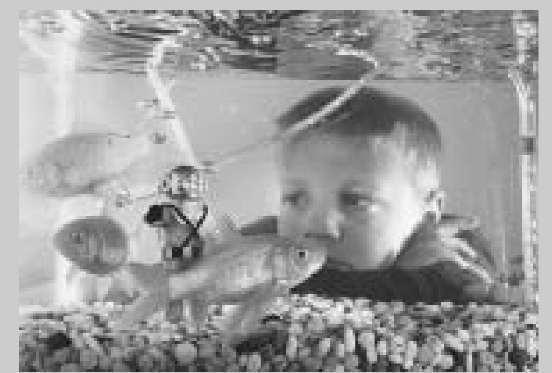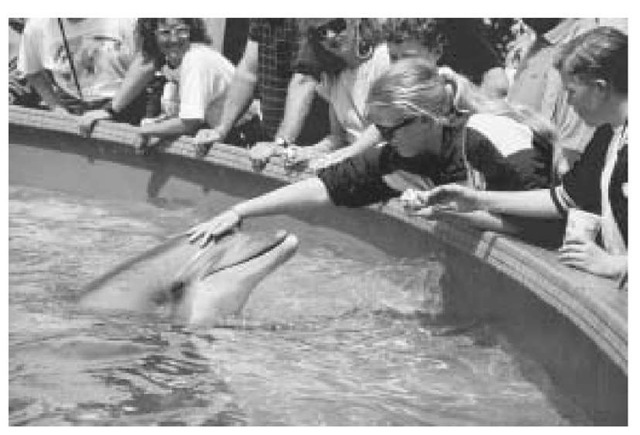An aquarium is any water-filled tank, pool, or pond in which fish, underwater plants, or animals are kept. An aquarium can be as small as a glass bowl for a goldfish and as large as a pool for a whale or a marine museum.
History of fish keeping
The ancient Sumarians (2500 b.c.e.) were the earliest fish keepers. Fish keeping developed as a way to provide and store food. Fish were caught in rivers and then kept in small ponds until they were used. The ancient Egyptians also kept fish in ponds, but not all of their ponds served a practical purpose. Egyptian hieroglyphs (a system of writing that used symbols and pictures) and art depict fish and fishponds as decorative objects.
In ancient Iran, China, and Japan, fish keepers bred special types of fish for use in decorative ponds. Fish keepers created koi, a popular decorative fish, by selectively breeding carp (a fish used for food) in pleasing colors and sizes. The present-day common goldfish, a close relative of the koi, is also a result of these ancient breeding practices.
The popularity of fish keeping spread to Europe and the United States in the eighteenth century, when ornamental fish were imported from the East. Fish keepers maintained ponds of ornamental fish, but the fish could only be viewed from above the water’s surface. Growing interest in the scientific study of plants and animals sparked curiosity about viewing marine life from below the surface of the water. In the nineteenth century, zoos, circuses, and natural history museums began to add fish and other marine creatures and plants to their exhibits.
Development of modern aquariums
The first public aquarium opened in London, England, in 1853. The aquarium was an instant success and several other public aquariums opened in England over the next 10 years. Although popular, these aquariums faced several difficulties. Tanks were limited in size because there were not strong enough materials to construct very large tanks. The tanks also lacked adequate support systems to keep the fish healthy. Without support systems to clean and heat the water, most fish did not survive. Aquariums had to frequently replace the fish in their exhibits.
In the 1870s, the first successful long-term aquariums opened. Improvements in glassmaking and metalwork permitted the construction of larger tanks to house marine exhibits. Scientists began to study aquatic habitats, the water environments in which plants and animals live, to gather information about water chemistry. When caring for fish, water chemistry concerns the temperature of water and its balance of minerals, salt, oxygen, and other particles. Aquarists (people who keep an aquarium) and scientists experimented with the water chemistry of aquarium tanks. New technologies allowed scientists to copy the water chemistry of marine and river environments. Filtration systems cleaned pollutants such as fish waste from the water. Aeration systems added air to the water to aid respiration (breathing) and keep the water moving. Moving water stayed cleaner. Heaters kept water in the tanks at appropriate temperatures. These support systems helped fish and other marine creatures in aquariums remain healthy.
By 1900, support systems permitted aquariums to house exotic tropical fish. Public aquariums competed for the most spectacular creatures and exhibits. Most of the creatures on display came from the ocean. Exotic marine creatures from faraway places were a favorite of aquarium visitors and few exhibits featured local or non-ocean species. The fish and other creatures were the focus of the exhibits. Tanks contained few plants.
Several technological advances in the second half of the twentieth century heightened scientific and public interest in the sea. Personal breathing systems for marine divers, nicknamed scuba (self-contained underwater breathing apparatus), permitted more lengthy underwater exploration. Small submersibles, sub- marine-like vessels usually driven by one to four persons, permitted some of the first glimpses of deep waters inaccessible to scuba divers. Cameras that could film underwater captured underwater images for both scientific study and public broadcast. A television series created by marine biologist Jacques-Yves Cousteau (1910-1997) featured underwater habitats, fish, and animals. The series made aquariums even more popular.
Greater scientific and public awareness of underwater life changed aquarium exhibits. Tanks began to copy whole marine habitats. Instead of featuring one type of fish, single tanks would recreate a part of the ocean. Coral reefs (underwater ridges of compacted coral), underwater rocks and coves, and plants were part of ocean landscapes featured in exhibits. Aquarists displayed many species of fish and other marine creatures together in tanks in groupings that appeared in nature. By recreating marine habitats, aquariums sought to show visitors a whole picture of life underwater.
Aquariums in the Home
Aquariums in the home are a popular hobby.
Many people keep fish and other marine creatures in aquariums as pets. With proper planning and care, home aquariums can be successful and healthy environments for fish.
Before starting an aquarium at home, home aquarists should research which size of tank and species of fish will that live in the aquarium. All the chosen species must be able to live in the same underwater environment and the same water chemistry. Often this will mean deciding between a freshwater and saltwater aquarium. For example, common freshwater goldfish cannot live in the same tank as tropical saltwater fish. Also, some popular fish, such as colorful betas, need to live alone because they will attack or eat other fish.
Like public aquariums, home aquarists are encouraged to copy their pet’s natural habitat and place plants, rocks, and corals in the aquarium. Before adding fish, an aquarium should be filled with water and plants. Aeration, filtration, and heating systems should run for at least one day before adding fish. It might be helpful to take a sample of the home aquarium water to the store where fish will be purchased. The water could then be tested to make sure it provides a proper environment for the fish.
Like all pets, taking care of an aquarium requires responsibility. Most fish need to be fed daily, but cannot be overfed. Sick or injured fish must be removed from the main tank and placed in a separate tank. Maintaining proper water chemistry, including aeration and temperature, is essential to the health and survival of fish. Water must be tested regularly and adjusted carefully. Home aquarists should also clean filters, aerators, and tanks when needed. Routine care for a home aquarium leads to better health for the fish and more enjoyment for their keepers.
A girl pets a dolphin at Sea World in San Diego, California.
Unlike the ornamental fishponds of ancient times, exhibits in aquariums are now designed and managed by scientists, such as marine biologists and ichthyologists (scientists who study fish). Today’s aquariums also feature a variety of underwater habitats including oceans, lakes, rivers, bays, and swamps. Some aquariums provide visitors with a look at underwater environments from two angles, above the water and below its surface. Many include exhibits where visitors can touch and handle underwater creatures such as sea stars, clams, and mussels.
Today’s aquariums still encourage visitors to have fun, but they also educate visitors about the preservation and protection of underwater habitats and species. Aquariums can show visitors healthy habitats in tanks next to pictures of natural habitats destroyed by pollution. Aquarium exhibits and programs educate the public about threats to natural underwater habitats and species from litter, chemicals, oil, and over fishing. Captive breeding programs in aquariums help preserve animals endangered by habitat loss or over fishing. Rescue programs provide medical care and shelter for animals and fish injured by litter, pollution, and oil spills.
WORDS TO KNOW
Aeration: Adding oxygen, nitrogen, and other gasses necessary for respiration into water.
Aquarist Person who keeps an aquarium.
Filtration: The process by which pollutants are removed from water.
Ichthyology: The scientific study of fish.
Water chemistry: The balance of nutrients, chemicals, and minerals in water.


